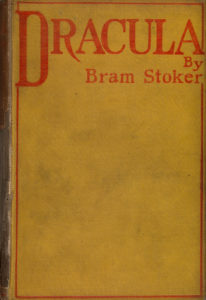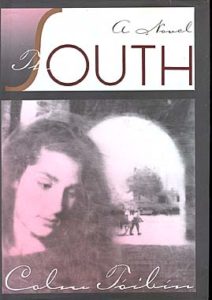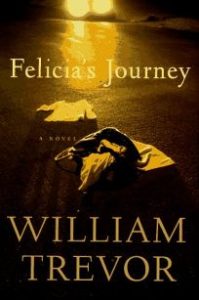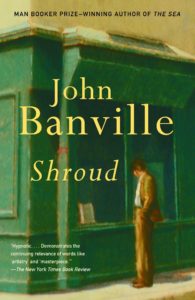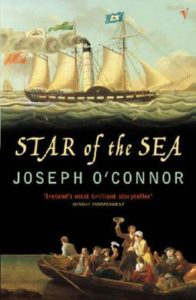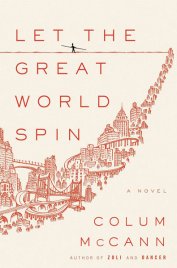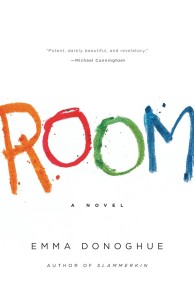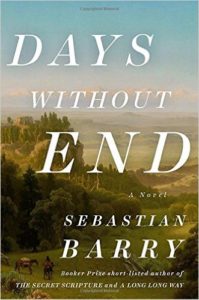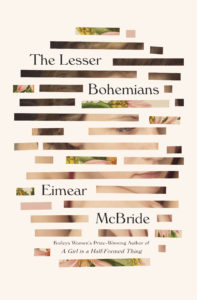
St. Patrick’s Day is upon us, a chairde, and what better way to mark the occasion than by curling up with a novel penned by an author from the Emerald Isle. The trouble is, there are far too many wonderful options to choose from: James Joyce’s Ulysses, Elizabeth Bowen’s The Last September, Flann O’Brien’s At Swim Two Birds, Máirtín Ó Cadhain’s Cré na Cille, Edna O’Brien’s The Country Girls, J. G. Farrell’s Troubles, John McGahern’s Amongst Women, Maeve Binchy’s Circle of Friends, Patrick McCabe’s The Butcher Boy, Roddy Doyle’s Paddy Clarke Ha Ha Ha, Anne Enright’s The Gathering, Kevin Barry’s City of Bohane, Belinda McKeon’s Tender, Mike McCormack’s Solar Bones, Sally Rooney’s Conversations With Friends, Anna Burns’ Milkman, and on, and on, and on…
Most of the above titles have very little in common with one another, stylistically or thematically, but they do all share one significant trait: like the vast majority of Irish fiction, each of these novels is set in Ireland. Despite being a country heavily shaped by, and preoccupied with, emigration, there are (relatively) few iconic Irish novels set away from the old sod. That got us thinking: why not make a list of great Irish novels that venture further afield, the ones set it far-flung places? So we did.
Here are ten of the best.
Happy St. Patrick’s Day!
*
The Picture of Dorian Gray by Oscar Wilde (1890)
The books that the world calls immoral are books that show the world its own shame.
Plot: A handsome young man makes a Faustian pact, remaining youthful as his hidden portrait wears his age and sins.
Setting: Victorian era London
“Why go grubbing in muck heaps? The world is fair, and the proportion of healthy-minded men and honest women, to those who are foul, fallen or unnatural is great. Mr Oscar Wilde has again been writing stuff that were better unwritten; and while The Picture of Dorian Gray, which he contributes to Lippincott’s, is ingenious, interesting, full of cleverness, and plainly the work of a man of letters, it is false art—for its interest is medico-legal; it is false to human nature—for its hero is a devil, it is false to morality—for it is not made sufficiently clear that the writer does not prefer a course of unnatural iniquity to a life of cleanliness, health and sanity. The story—which deals with matters only fit for the Criminal Investigation Department or a hearing in camera—is discreditable alike to author an editor.
Mr. Wilde has brains, and art, and style; but if he can write for none but outlawed noblemen and perverted telegraph-boys, the sooner he takes to tailoring (or some other decent trade) the better for his own reputation and the public morals.”
–The Scots Observer, July 5th, 1980
Listen to them, the children of the night. What music they make!
Dracula by Bram Stoker (1897)
Plot: A stranger comes to town…and that stranger is Count Dracula.
Setting: England and Transylvania
“A writer who attempts in the nineteenth century to rehabilitate the ancient legends of the were-wolf and the vampire has set himself a formidable task. Most of the delightful old superstitions of the past have an unhappy way of appearing limp and sickly in the glare of a later day, and in such a story as Dracula, by Bram Stoker, the reader must reluctantly acknowledge that the region of horrors has shifted its ground. Man is no longer in dread of the monstrous and the unnatural, and although Mr. Stoker has tackled his gruesome subject with enthusiasm, the effect is more often grotesque than terrible.
The Transylvanian site of Castle Dracula is skillfully chosen, and the picturesque region is well described. Count Dracula himself has been in his day a medieval noble, who, by reason of his ‘Vampire’ quilters, is unable to die properly, but from century to century resuscitates his life of the ‘Un-Dead,’ as the author terms it, by nightly droughts of blood from the throats of living victims, with the appalling consequence that those once so bitten must become vampire in their turn.
The plot is too complicated for reproduction, but it says no little for the authors powers that in spite of its absurdities the reader can follow the story with interest to the end. It is, however, an artistic mistake to fill the whole volume with horrors. A touch of the mysterious, the terrible, or the supernatural is infinitely more effective and credible.”
–The Manchester Guardian, June 15, 1897
The South by Colm Tóibín (1990)
There will always be reservations, things one must leave out, events one can’t explain without handing over a full map of one’s life, unfolding it, making clear that all the lines and contours stand for long days and nights when things were bad or good, or when things were too small to be described at all: when things just were. This is a life.
Plot: An upper-class landed Protestant woman abruptly leaves her husband, child and Ireland, for an unknown future in Barcelona.
Setting: 1950s-1970s Catalonia
“A novel written with grace and intelligence yet not overblown with cumbersome literary pretensions is, these days, a rare delight; such is Colm Toibin’s The South, recently shortlisted for the Irish Times-Aer Lingus Literature Prize for first book. Toibin is concerned with the kinds of exile, interior civil war and orphanage produced by the deadly historical split of countries such as Ireland and Spain. The Joycean technique of intense recall of one country, from the perspective of another, wonderfully serves Toibin’s endeavor … Some of the novel’s haunting quality is due to its mysteries, the tremendous amount Toibin leaves unsaid. I do admire his oblique way of handling themes of exile and civil war, yet there are times one needs a little more information … In the hands of a lesser novelist so many generations of wound and loss could easily have resulted in a soggy saga. But Toibin’s talent is amazing. His skilled short hand technique for turning Spain into Ireland, and Ireland, Spain, has birthed a stunning, and very particular novel.”
–Barbara Probst Solomon, The Washington Post, September 22, 1991
Felicia’s Journey by William Trevor (1994)
Only being together, only their love, can bring redemption.
Plot: An unmarried Irish girl, adrift and friendless in the industrial English Midlands, searches for the father of her unborn child.
Setting: The English Midlands
“William Trevor is an Irishman who lives in England and writes often about the English. He is a moral realist who possesses a deliciously dry wit, a nice sense of the macabre and a warm sympathy for the flawed and suffering characters he creates with such fine psychological precision. There is a conviction implicit in all his work that people divide into predators and prey, that the human condition is marked by secrecy, shame, deceit, blindness and cruelty, and that evil not only exists but also can be understood, and can even be vanquished by unpredictable eruptions of grace.
…
“…the reader is utterly engaged in Felicia’s plight and feels frantic but helpless, wanting to cry out to the young woman not to go near this man—to go home, to go anywhere, to flee him. But of course, Felicia does not know the danger she is in. And curiously, neither do we, precisely. For although Mr. Trevor has skillfully persuaded us to believe that Mr. Hilditch is a monster who intends to do Felicia serious harm, he has not been at all specific. This, in part, is what makes Felicia’s Journey such a good read: its vague, tantalizing suggestion of unspeakably evil acts being hatched in the black, foul-smelling cellars of Mr. Hilditch’s mind and the pleasurable frustration aroused by the fact that we cannot know, at least not yet, the form these horrors will take … Felicia’s Journey confirms the maxim that to understand all is to forgive all, and it demonstrates as well that in hands like Mr. Trevor’s, fiction is a tool without equal for creating such understanding.”
–Patrick McGrath, The New York Times, January 8, 1995
Shroud by John Banville (2002)
I lied to escape, I lied to be loved, I lied for placement and power; I lied to lie.
Plot: Axel Vander, famous man of letters and recently widowed, travels to Turin to meet a young woman called Cass Cleave. Cleave is a literary researcher who has discovered two terrible secrets about Vander’s early years in Antwerp.
Setting: 1980s Turin
“Banville, as much as any author today, demonstrates the continuing relevance of words like ‘artistry’ and ‘masterpiece.’ In Shroud, Banville’s protagonist is loathsome, his supporting cast uniformly unattractive; yet he is so successful at capturing these people’s terrible, desperate (and, in Vander’s case, morally repugnant) humanity that we’re fascinated by them nonetheless—and are reminded that in the end there are few more potent rebukes to reductive and dehumanizing creeds than highly accomplished literary art.”
–Bruce Bawyer, The New York Times, March 16, 2003
Star of the Sea by Joseph O’Connor (2003)
Love and freedom are such hideous words. So many cruelties have been done in their name.
Plot: A glimpse into the lives of a few desperate refugees, fleeing the Irish famine, among hundreds traveling on board a coffin ship bound for America.
Setting: A coffin ship sailing across the Atlantic Ocean in 1847
“Star of the Sea is a polyphonic novel, as different voices, social accents and national idioms weave their way in and out of the text. But if its tone is that of sober English realism, its structure is that of Irish literary experiment. The book is a montage of verbal forms: letters, quotation, first-person narrative, Hansard, captain’s log, snatches of ballad, advertisements, news-paper clippings, historical documentation.
The ship is a microcosm of Irish society, the place where a number of different narratives converge, as they do in a piece of fiction. But the novel also traces each of these personal histories back to its roots, through love story and rogue’s progress, tale of vengeance and big-house drama. There are several novellas tucked inside this well-upholstered text, along with cameos of the East End, snapshots of Victorian Belfast, and vignettes of the Irish land-owning aristocracy.
The society that has only its contemporary experience to live by is poor indeed. With this stunningly accomplished novel, Irish fiction, for so long a prisoner of the present, breaks out into a richer, stranger country.”
–Terry Eagleton, The Guardian, January 25, 2003
Let the Great World Spin by Colum McCann (2009)
The world spins. We stumble on. It is enough.
Plot: A portrait of Manhattan and its inhabitants in the 1970s and onward, catalyzed by Philippe Petit’s famous tightrope walk between the Twin Towers.
Setting: New York City
“Let the Great World Spin is a birth certificate chiseled on a tombstone, and, as such, it’s not so much a historical novel as it is a novel abouthistory—about how it works … It is a book so humane in its understanding of original sin that it winds up bestowing what might be called original absolution, and it is a pre-9/11 novel that delivers the sense that so many of the 9/11 novels have missed … Let the Great World Spin stands as a kind of corrective to Don DeLillo’s remorselessly precise and punishing Falling Man. Call it Floating Man, for it is a book so humane in its understanding of original sin that it winds up bestowing what might be called original absolution, and it is a pre-9/11 novel that delivers the sense that so many of the 9/11 novels have missed: We are all dancing on the wire of history, and even on solid ground we breathe the thinnest of air.”
–Tom Junod, Esquire, July 8, 2009
Room by Emma Donoghue (2010)
Scared is what you’re feeling. Brave is what you’re doing.
Plot: A five-year-old boy, Jack, and his mother live in captivity in a single squalid room.
Setting: Unspecified
“Emma Donoghue’s remarkable new novel is built on two intense constraints: the limited point of view of the narrator, a 5-year-old boy named Jack; and the confines of Jack’s physical world, an 11-by-11-foot room where he lives with his mother. We enter the book strongly planted within these restrictions … Jack’s voice is one of the pure triumphs of the novel: in him, she has invented a child narrator who is one of the most engaging in years—his voice so pervasive I could hear him chatting away during the day when I wasn’t reading the book. Donoghue rearranges language to evoke the sweetness of a child’s learning without making him coy or overly darling; Jack is lovable simply because he is lovable … There’s a lot to manage—the external, vivid, social world is a huge and gratifying resource here, and Jack’s eyes remake the familiar. It is invigorating, watching him learn, and the way Donoghue reveals the consequences of Room through her attention to detail is tremendous … This is a truly memorable novel, one that can be read through myriad lenses—psychological, sociological, political. It presents an utterly unique way to talk about love, all the while giving us a fresh, expansive eye on the world in which we live.”
–Aimee Bender, The New York Times Book Review, September 16, 2010
Days Without End by Sebastian Barry (2016)
We have our store of days and we spend them like forgetful drunkards.
Plot: Thomas McNulty, aged barely 17 and having fled the Great Famine in Ireland, signs up for the U.S. Army in the 1850s. With his brother in arms and lover, John Cole, Thomas goes on to fight in the Indian Wars and the Civil War.
Setting: 1850s American West
“Barry’s business extends beyond intense and visceral description, though that persists through a narrative that eventually encompasses the American civil war as well as increasingly complex interactions with indigenous communities. It also captures the development of Thomas and John’s relationship, the men’s sexual attraction to one another announced early in the novel by the simple, paragraph-long sentence: ‘And then we quietly fucked and then we slept.’ What makes this strand of storyline unexpected is that it ushers in an exploration of gender fluidity and a redefinition of family that seems to scream anachronism but is nonetheless convincing … Days Without End is a work of staggering openness; its startlingly beautiful sentences are so capacious that they are hard to leave behind, its narrative so propulsive that you must move on. In its pages, Barry conjures a world in miniature, inward, quiet, sacred; and a world of spaces and borders so distant they can barely be imagined.”
–Alex Clark, The Guardian, October 28, 2016
The Lesser Bohemians by Eimear McBride (2016)
Life makes itself with little heed for the appropriate.
Plot: 18-year-old Eily, newly arrived in London from Ireland to begin drama school, begins an intense affair with an older actor.
Setting: London, 1994
“Not often does a novel so expertly seduce its readers into an alternate state of consciousness that it mimics an actual dream state, where everything solid is hazily just beyond reach. Eimear McBride, with her deployment of modernist technique reminiscent of James Joyce, elicits such a mental state throughout her new novel, The Lesser Bohemians― really, it’s the only way to read it … The Lesser Bohemians, in short, doesn’t ease readers in. Instead, it teaches us to understand and bend to its unusual cadences and the unpredictable rules of its tiny universe. It’s not a book you’ll want to repeatedly take up and put down, because the most satisfying moments spent with it come after you’re dozens of pages in, when you realize that instead of struggling against the current you’ve been caught up irresistibly in its powerful pull.”
–Claire Fallon, The Huffington Post, October 1, 2016
Night Boat to Tangier by Kevin Barry (2019)
He was more than possessed by his crimes and excesses—he was the gaunt accumulation of them.
Plot: Maurice and Charlie, two old friends and former drug-smuggling partners, keep a nocturnal vigil at a Spanish ferry terminal, waiting for Maurice’s estranged teenage daughter to appear.
Setting: A ferry terminal in the Spanish port of Algeciras, 2018
“… it’s Barry’s voice that propels us through the work, through paragraphs punctuated by turns of phrase that deliver little jolts of pleasure. Like their author, his characters are aware of the implications and ironies of language … Barry’s control of tone is so assured that he can turn a fragment of autobiography, confession, and apology into a terrifying threat … No matter how funny and smart, abrasive and irreverent the dialogue is, we’re never allowed to forget that ‘their talk is a shield against feeling’ … Night Boat to Tangier is about the present and the past, about memory and loss, which is partly why it’s a sadder and more beautiful book [than Barry’s City of Bohane] … The unconventional paragraphing compels us to focus; there’s no room for the mind to wander in the midst of a long passage of prose … formally daring and inventive … I’ve missed Maurice and Charlie ever since I finished Barry’s novel … Night Boat to Tangier—and much of Barry’s work—inspires us to rethink our ideas of character, of compassion and forgiveness. Without romanticizing crime, they humanize the criminal.”
–Francine Prose, The New York Review of Books, April 9, 2020


